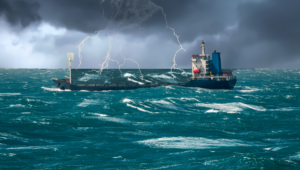Whether one believes that climate change is accelerated by human activity or not, the fact that the earth’s climate has changed (and continues to change) is undeniable. Some of the more dire predictions related to climate change have to do rising ocean levels. “In 1995 a report from the International Panel on Climate Change estimated that the sea will rise 50 centimeters (20 inches) with lowest range at 15 centimeters (6 inches) and high range at 95 centimeters (37 inches) by 2100, and NASA’s take is supported with lots of evidence the warming is accelerating (temperature trends, sea level trends ) might come at us in a rush. If you go here, you can dial in the rise in water levels and see which properties will be waterfront if that occurs.” [“How far below sea level will your home be if …,” Gizmag, 25 August 2006]. Before you start thinking that this post is about climate change, I’ll tell you that it’s not. Climate change (and the predictions about rising sea levels) simply provided the inspiration for some clever individuals and companies who asked: What if sea levels do rise dramatically? Can a different kind of coastal living experience be created?
These are important questions because two historical trends (urbanization and coastal living) are on a collision course with rising sea levels. It has been estimated that as of last year 80 per cent of people on earth live within 60 miles of the coast. To cope with rising sea levels, some designers have suggested that we build floating cities that are ambivalent to sea level data. Will “floating cities” ever be built? I don’t know — but I never say never. I suspect that the devastating tidal waves that struck Japan and Southeast Asia over the past few years will make a lot of people pause. Even if they aren’t built, however, the thinking that has gone into some of the creative designs for floating cities could prove valuable in the future. So let’s look at a few designs that have been uncovered by the staff at Gizmag.
Green Float
The first concept, called Green Float, comes from Japan’s Shimizu Corporation [“Green Float concept: a carbon negative city on the ocean,” by Darren Quick, Gizmag, 23 November 2010]. Quick reports, “The concept would comprise individual floating cells or districts resembling water lilies with a radius of 1km (0.62 miles) that would form a compact village that could house 10,000 to 50,000 people.” Below is a side view of one of proposed cells.
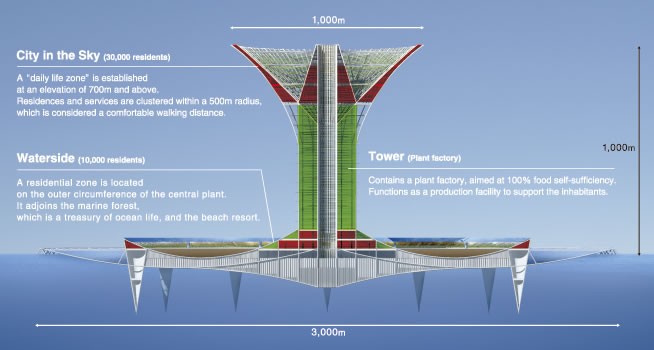
Individual cells, according to Quick, would be linked together to form larger entities. The tower in the center of the cell is the highrise city where the majority of inhabitants live. Quick explains:
“The majority of the inhabitants would live in 1km high ‘City in the Sky’ towers located at the center of the circular cells, while additional ‘Waterside’ residential zones comprising low-rise townhouses would be located on the outer edge of the structure’s outer circumference. To take advantage of the cooler temperatures, the tower residences and services would be located at the top of the tower at an elevation of 700 m (2,296 ft), providing year-round temperatures of 26-28 °C (79-82 °F). As the population of the cities grow, additional cells could be added, spreading out like the water lilies they resemble. The central tower would be surrounded by grassland and forests, while the outer circumference would adjoin marine forests, lagoons and beach resorts. The cells are designed to be completely self-sufficient in terms of food with the 1 km high towers containing a plant factory, while livestock and other farming would take place in ‘plains’ also surrounding the tower. Seafood lovers would obviously also be well catered for through fishing the surrounding ocean and the marine forests.”
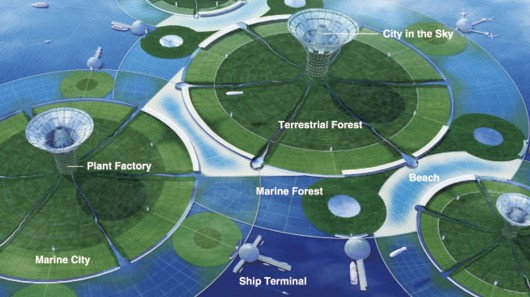
There is a catch. Like me, you might be wondering how this kind of floating city would weather severe storms, like hurricanes. It turns out that avoiding that kind of weather is critical to the plan. Quick indicates that if you were planning on parking your floating city off of Tokyo or New York, you should forget about it. He explains:
“The islands would be located at the equator as it isn’t prone to typhoons and the climate is stable. However, in the event of large waves, strong elastic membranes would be attached to the lagoons around the outer circumference of the cells, with the shallows above the membranes standing 10m (32.8 ft) above sea level. The water pressure difference between the lagoons and the ocean would limit the movement of the membranes and buffer the force of the open sea waves. Additionally, 20-30m (66-98 ft) high seawalls would be constructed to handle a worst-case scenario.”
Quick reports that the Shimizu Corporation is not the only group that took its inspiration from the lilypad. Architect Vincent Callebaut also drew inspiration from the lilypad for the next concept.
Lilypad
According to Quick, “the ‘Lilypad’ concept [is] a completely self-sufficient floating city that would accommodate up to 50,000.” [“Lilypad floating city concept,” Gizmag, 26 January 2011]. Callebaut apparently foresees his floating city as a place to live for people who have lost their homes due to rising sea levels. Unlike Green Float, which is intended to be located near the equator, renderings of the Lilypad show it just offshore a major city.
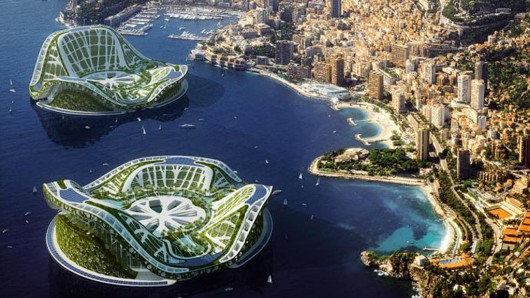
Quick reports, “The Lilypads could be located close to land or set free to follow the ocean currents wherever they may lead.” Considering the rise in piracy, my bet is that if the Lilypad were ever built it wouldn’t be “set free to follow the ocean currents.” Quick continues:
“With a shape inspired by the highly ribbed leaf of Victoria water lilies, the double skin of the floating ‘ecopolis’ would be made of polyester fibers covered by a layer of titanium dioxide (TiO2), which would react with ultraviolet rays and absorb atmospheric pollution via a photocatalytic effect.”
Although both Green Float and Lilypad draw inspiration from the lowly lilypad, they look dramatically different. The Lilypad boasts “three marinas and three mountains [which] surround a centrally located artificial lagoon that is totally immersed below the water line to act as ballast for the city.”
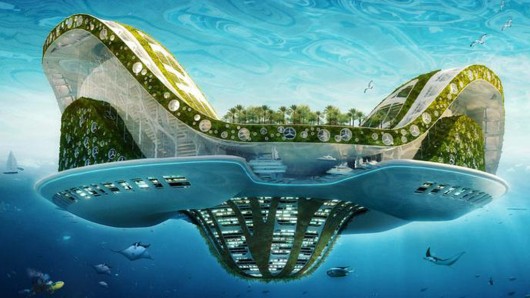
According to Quick, “The three mountains and marinas would be dedicated to work, shopping and entertainment, respectively, while suspended gardens and aquaculture farms located below the water line would be used to grow food and biomass. The floating city would also include the full complement of renewable energy technologies, including solar, thermal, wind, tidal, and biomass to produce more energy than it consumes.” Callebaut would like to see his Lilypad concept become a reality by 2100, but Quick reports that may be too late to help populations displaced by rising sea levels. Quick concludes:
“While Callebaut’s Lilypad concept is admirable in its aim of providing a home for displaced climate change refugees, it seems that these same people would be the last ones to be able to afford a place on what would likely be an enormously expensive piece of real estate.”
The next concept also draws it inspiration from nature and comes from the Russian architectural firm Remistudio.
The Ark
The Ark is more of a floating hotel than a floating city; although it “would float and function independently on the surface of a body of water, providing a green, self-sustaining environment for guests who presumably, would never have to leave” [“Oasis at sea: The Ark hotel concept,” by Bridget Borgobello, Gizmag, 30 December 2010]. The outer design of The Ark draws inspiration from seashells rather than from the lilypad.
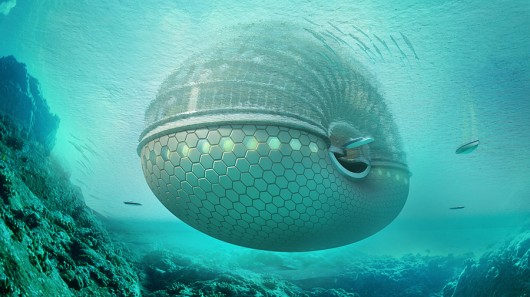
Borgobello reports that The Ark is “designed to withstand floods, tidal waves and rising ocean levels as well as earthquakes and other natural disasters.” She continues:
“The shell-inspired Ark design has a load-bearing system of arches and cables which maintain an even weight distribution to withstand earthquakes, whilst the prefabricated frame allows for a fast and easy construction. The internal garden provides a lush escape for guests by acting as a greenhouse and enough daylight is filtered throughout the internal rooms to reduce the need for lighting. The design also integrates photovoltaic solar cells, a rainwater collection system and a frame that is protected with layer of self-cleaning and recyclable ethyltetrafluoroethylene (ETFE). … Aside from the eco-credentials, it’s a stunning design that seems to jump straight out of a science-fiction film. We can only hope that the worst global warming predictions prove inaccurate and it doesn’t become the 22nd Century’s holiday destination of choice.”
The final two concepts move inshore and are intended for use on the world’s rivers rather than its seas.
The New Orleans Arcology Habitat (NOAH)
“Arcologies … are essentially entire cities crammed into a single high population density megastructure” [“Floating megacity designed for the banks of the Mississippi,” by Darren Quick, Gizmag, 3 February 2011]. The inspiration for NOAH came “with the rebuilding of New Orleans after Hurricane Katrina.” According to Quick, “A group of designers … [conceived a] structure would house 40,000 residents along with all services and amenities that would allow them to live their entire lives within its walls if they so desired.” He continues:
“With much of New Orleans built below sea level and the city prone to extreme winds, NOAH’s designers chose to go with the concept of a floating structure whose open triangular frame shape is designed to dissipate severe winds by allowing weather to blow through the structure in any direction with a minimum of massing interference. The structure’s outer edges are also curved and tilted to further dissipate wind loads, while both curved and flat surfaces would be outfitted with secured sliding hurricane panels to form a protective exterior barrier. While the 1,200 ft (366 m) structure is actually designed to float, it wouldn’t be set adrift on the Mississippi. Instead a water filled basin around 1,200 ft (366 m) in diameter and 250 ft (76 m) deep would be constructed on the bank of the Mississippi. The basin would partially be carved out of the existing land and also extended out into the river. The actual foundation of the NOAH superstructure would then float within the basin thanks to its multi-cavity ‘hull’ consisting of high strength concrete cells that form a matrix of approximately 40 x 40 cells. This matrix is designed to give the structure buoyancy and form the frame for the steel framed superstructure. The designers estimate that structure will draft 180 ft (55 m) within the water-filled basin, allowing for a minimum 50 ft (15 m) space between the floor of the basin and the floor of NOAH’s foundations.”
Quick explains that “the NOAH design team sees the structure as a viable plan, not only for New Orleans but for any coastal urban area. And while there are many advantages to the concept of arcologies, they remain very much on the drawing-board at this stage.” The final concept is a departure from the concepts discussed above in that it is more of a garden than a city.
Physalia
Physalia is a floating amphibious garden designed by Vincent Callebaut, who also designed the Lilypad discussed earlier. The idea is that the Physalia “can clean … rivers as it travels the waterways of Europe.” [“Amphibious floating garden concept would clean rivers across Europe,” by Paul Ridden, Gizmag, 15 February 2011]. Presumably the floating garden could be used on any river not just Europe’s. Ridden continues:
“Callebaut … says that the vessel’s structural design was inspired by the physalia physalis (commonly known as the jellyfish-like Portuguese man o’ war), from the Greek for bladder or water bubble. As the craft wanders the waterways between the Danube and Volga, the Rhine and Guadalquivir, or the Euphrates and Tiger, a hydraulic network in its aluminum-covered, double hull will enable it to filter river water through to the planted roof for some natural purification.”
These are not the only concepts for amphibious cities floating around. For example, there’s the Freedom Ship, a massive ship that would be close to a mile long, with a full scale airstrip on the roof and 50,000 people aboard. [“New Freedom Ship design unveiled,” by Mike Hanlon, Gizmag, 29 June 2003]. Although none of these concepts may ever come to fruition, the ideas behind them and technologies they might inspire could have an impact on the future.




